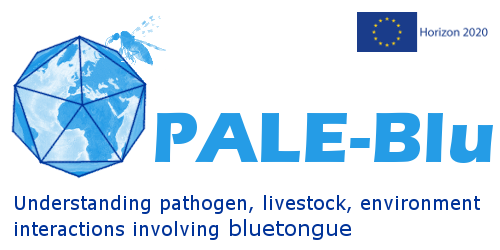Bluetongue in Europe
Bluetongue virus (BTV) is transmitted by Culicoides biting midges and was previously confined to tropical and sub-tropical regions but is now endemic in several Southern European countries, including Cyprus, Greece, Spain, Portugal, Italy and France (Corsica). Epidemiological studies and phylogenetic analyses (primarily by members of the PALE-Blu consortium) have identified new introductions or discoveries of the virus in Europe each year since 1998, involving eleven distinct BTV serotypes (BTV-1, 2, 4, 6, 8, 9, 11, 14, 16, 25, and 27).
Bluetongue disease (BT) represents an important threat to livestock health and food production in Europe and neighbouring countries. The continuing arrival of new ‘exotic’ strains from neighbouring regions, suggests that incursions by BTV (and possibly by related orbiviruses and other arboviruses) are likely to continue in Europe for the foreseeable future.
BTV Outbreaks: The first outbreak of bluetongue (BT) ever recorded in Northern Europe (caused by BTV8) was initially detected in the Netherlands during August 2006, before spreading across almost the whole of Europe during subsequent years. This outbreak killed many hundred thousand animals (mainly sheep) with an estimated 25% case fatality rate, along with economic losses due to movement restrictions (loss of trade), loss in productivity and reproductive performance (in both cattle and sheep), as well as surveillance and vaccination costs. Although the outbreak was controlled by vaccination in 2008-2009, the same virus strain recently reemerged in central France during August 2015. In 2014 a novel multi-reassortant BTV-4 strain emerged in Southeast Europe (probably derived from North Africa) and moved northward reaching Central Europe (Austria) in late 2015. By the end of the summer of 2016, the same serotype was also detected in both southern and north-eastern Italy, Montenegro and Bosnia-Herzegovina.
This presentation from the European Commission presents The Bluetongue outbreaks by month over the last decade...
To learn more about bluetongue control and prevention strategies click here...




